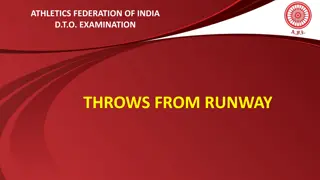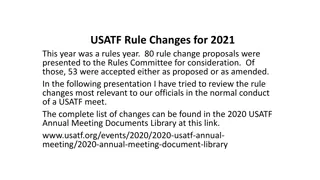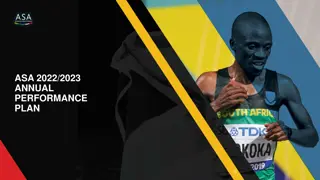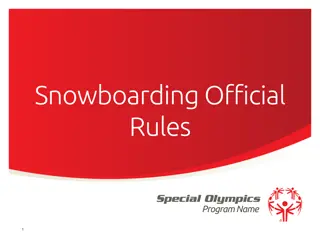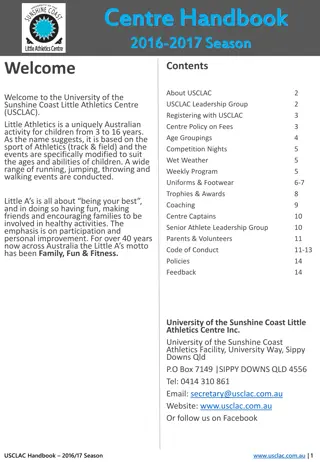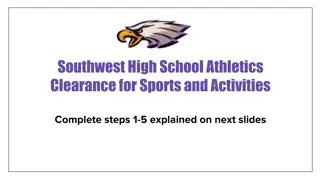Athletics Official Rules Program Overview
This content provides an overview of the Athletics Official Rules Program, including the sport season, culminating events, events offered, recommended events based on ability levels, and uniform guidelines. It covers a wide range of events from running to walking to field activities, offering detailed information to participants and officials involved in the program.
Download Presentation

Please find below an Image/Link to download the presentation.
The content on the website is provided AS IS for your information and personal use only. It may not be sold, licensed, or shared on other websites without obtaining consent from the author.If you encounter any issues during the download, it is possible that the publisher has removed the file from their server.
You are allowed to download the files provided on this website for personal or commercial use, subject to the condition that they are used lawfully. All files are the property of their respective owners.
The content on the website is provided AS IS for your information and personal use only. It may not be sold, licensed, or shared on other websites without obtaining consent from the author.
E N D
Presentation Transcript
Athletics Official Rules Program Name 1
The Basics Sport season: April-June Culminating State Events: State Summer Games Alpine Skiing
Events Offered: Events Offered Running Walking Wheelchair Field Events -50 M Dash -100 M Dash -200 M Dash -400 M Dash -800 M Run -1500 M Run -5000 M Run -4x100 M Relay -4 x 100 Meter Unified Relay -4 x 400 Meter Unified Relay -100 M Walk -200 M Walk -400 M Walk -800 M Walk Non Motorized Wheelchair Events: -10 M Wheelchair Race -25 M Wheelchair Race -30 M Slalom Race -50 M Slalom Race -4X25 M Wheelchair Shuttle Relay Race Motorized Wheelchair Events: -25 M Obstacle Race -30 M Slalom -50 M Slalom -Standing Long Jump -Running Long Jump -Softball Throw -Shot Put -High Jump -Mini Javelin -Pentathlon -Wheelchair Shot put Developmental Walking Events: -10 M Assisted Walk -25 M Assisted Walk -25 M Unassisted Walk -50 M Unassisted Walk Developmental Field Events: -Ball Throw (distance) -Frisbee 3
Recommended Events for Appropriate Ability levels Recommendation: If an athlete runs 10 seconds or less in the 50 Meter Dash he/she should be entered into the 100 Meter Dash If an athlete is registered for: They cannot also be registered for (and vice versa): Standing Long Jump Running Long Jump Walking Events Running Events Softball Throw Shot Put & Mini Jav Wheelchair Events Running or walking events Developmental Events All other events 4
Uniform Guidelines and Uniform Guidelines and Equipment Equipment 1.The preferred Uniform is a Tank-top type jersey and lightweight running shorts. 2.In all events, competitors must wear clothing that is clean, designed and worn so as not to be objectionable. 3.Clothing must be made of a material, which is non-transparent even when wet. 4.The competitors must not wear clothing that could impede the view of the judges. 5.Jewelry is prohibited. 6.Competitors may compete in bare feet or with proper athletic footwear on one or both feet. I. The purpose of shoes for competition is to give protection and stability to the feet and a firm grip on the ground. II. Such shoes, however, must not be constructed so as to give the competitor any additional assistance, and no spring or device of any kind may be incorporated in the shoes. III. A strap over the instep is permitted. IV. Although it is discouraged, track spikes measuring no longer than 1/4" can be used at Central Michigan University's track. Spikes not meeting that specification will be prohibited. Alpine Skiing
General Rules Program Name 6
General Rules for Athletics 1. Due to the possibility of very low registration numbers, the following events may be combined and run as open divisions: 800 M Run, 1500 M Run, 5000 M Run and 4x100 M Relay. This means combining males and females and all age groups. Athletes will be awarded separately. 2. Blind and Deaf Athletes: A rope or bell may be provided to assist athletes who are visually impaired. A tap start may be used for an athlete who is both deaf and blind. A sighted guide may lead, but not pull or prompt, the athlete in any manner. Alpine Skiing
Relays I. If an athlete is dropped and no registered alternate is available the entire relay team is dropped. II. 4 x 400 Meters: A three-turn stagger will be used for the start. The first leg will be run entirely in lanes. The second leg runner will start in his/her lane and will run in their lanes through the first turn as far as the edge of the breakline where athletes may leave their respective lanes. III. In the 4 x 400 meters relay where not more than four teams are competing, it is recommended that only the first bend of the first lap should be run in lanes. In a given competition, however, all races of 4 x 400 meters relay shall be run only in one of the above mentioned formats. Alpine Skiing
Starts I. Due to time constraints, starting blocks will not be utilized at State Summer Games. II. All athletes shall start from behind the start line. A runner completes the race when his/her torso reaches the perpendicular plane of the nearer edge of the finish line. III. In competition, the commands of the Starter shall be on your marks, set, and when all competitors are set, the gun shall be fired. IV. In races 800 M or longer, the command shall be on your marks and when all competitors are steady, the gun shall be fired. A competitor shall not touch the ground with his/her hands. 9
Starts Cont. V. 800 M distance: athlete will run/walk in the lanes through the first turn and break toward lane one at the break line marked after the first turn VI. 1500 M and greater distances: A waterfall start shall be used VII. The starter shall give each competitor a chance to do his/her best by: Giving the competitors ample time to settle down after taking their marks. Starting the sequence over if any runner is off-balance. Not holding the runners too long after the set command VIII. False Starts: Only one false start per race shall be allowed without the disqualification of the athlete responsible for the false start. 10
Lane Violations I. In all races ran/walked in lanes, each competitor shall keep within his allocated lane from start to finish. II. If a competitor is pushed or forced by another person to run outside his lane, and if no material advantage is gained, the competitor should not be disqualified. III. If an athlete either: Moves outside his/her lane in the straight or moves outside the outer line of his lane on the bend, with no material advantage thereby being gained, and no other runner is obstructed, then the competitor should not be disqualified. 11
Events Program Name 12
Walking Events I.Athletes must have one foot in touch with the ground at all times. In all race walking events, an athlete does not have to have a straight advancing leg while competing. II. In race walking events, up to and including the 400 meters, the competitor shall be disqualified with no prior warning when, in the opinion of two or more officials, a technical violation has been committed that results in an advantage being gained. III. Due to the possibility of very low registration numbers, the following events may be combined and run as open divisions: 800 M Walk. This means combining males and females and all age groups. Athletes will be awarded separately. 13
Developmental Walking I.Assisted Walk: Athletes must provide their own assisted devices. Assisted devices may consist of canes, crutches or walker. II. Each athlete will use two lanes as his/her lane, sufficiently wide enough to allow for assistive devices. Place cones on the start and finish lines, 2.44 meters apart (two track-lanes width) to create four start and four finish gates and four lanes. Beginning at the start line, place one cone on each lane line at five meter intervals. Cones should be placed in the middle of the lane line. III. Athlete starts behind the start line with a walking aid and walks using a walking aid. Athlete stays in his/her designated lane. Athlete may not receive physical assistance from coaches, officials, or any other volunteer. Athlete is timed from the smoke of the starter s gun to when his/her torso reaches the perpendicular plane of the nearer edge of the finish line. IV. Unassisted Walk: Rules are the same as the Assisted Walks, but the athlete will not be permitted to use a walking aid 14
Wheelchair Events Program Name 15
General Rules I. Athletes shall start with all wheels behind the start line. Athlete is timed from the smoke of the starter s gun to when all front wheels (two or one) of the wheelchair reach the perpendicular plane of the nearer edge of the finish line. II. The lanes for the wheelchair events shall be made two track-lanes wide. III. Motorized wheelchairs shall not be allowed in regular wheelchair races. IV. Only athletes who ambulate by use of a wheelchair may participate in the events. V. Athletes shall not be pushed, pulled or otherwise assisted during these events. VI. Each competitor must keep in his/her lane from start to finish and may not interfere, obstruct or impede the progress of another competitor. Infractions, at the discretion of the judges, may result in disqualification. 16
30/500 M Slalom i. Beginning at the start line, place one cone in each lane at five meter intervals. Cones should be placed in the middle of the lanes. ii. Athlete maneuvers his/her chair through the course, going to the right of the first obstacle and across the finish line without impeding another athlete on the course. iii. Knocking down a marker constitutes a violation, and a three-second penalty will be assessed. 17
4x25 M Wheelchair Shuttle Relay I. Four persons shall make up a team. Each competitor will complete 25 meters of the relay. II. The second, third and fourth competitors of a team may not leave the start line until the leading wheels on the wheelchair of the teammate who precedes him/her crosses a takeoff line 1 meter in front and parallel to the starting line. III. The fourth competitor completes the race when the first two wheels cross the finish line. 18
Motorized Wheelchair Race Rules I.These events are restricted to motorized wheelchairs only. II. The first two wheels on each competitor s wheelchair will be regarded as the starting and finishing points of all races. III. If a competitor varies from a sequence of obstacles, he/she must, without notice from any official, resume progress at the point prior to the incorrectly passed obstacle before entering the next obstacle and complete the course in its entirety, or be disqualified. In essence, failure to complete the course as designed will result in disqualification. IV. A competitor will be disqualified if that individual s coach, or assistants, enter the course boundaries during the running of the obstacle course. Coaches may instruct from outside the marked boundaries of the course. Judges and officials will not give directional cues. V. Athlete is timed from the smoke of the starter s gun to when the front wheels of the wheelchair reach the perpendicular plane of the nearer edge of the finish line. VI. All motorized wheelchairs shall be set on a High Speed setting. 19
30/50M Motorized Wheelchair Slalom i. Each athlete will use two lanes as his/her lane, sufficiently wide enough to allow for wheelchairs. ii. Place the cones on the start and finish lines 2.44 meters apart (two track-lanes width) to create four start and four finish gates and four lanes. Beginning at the start line, place one traffic cone (slalom flagpoles minimum of 1.22 meter) in each lane at 5-meter intervals. Cones should be placed in the middle of the lanes. iii. Athlete maneuvers his/her chair through the course, going to the right of the first obstacle and across the finish line without impeding another athlete on the course. iv. Knocking down a cone constitutes a violation, and a three-second penalty will be assessed. No penalty will be incurred as a result of touching/ moving a cone. 20
25 M Obstacle Race i. Mark one box two meters from the start line and one box two meters from the finish line. Each box should be three meters by three meters wide. ii. Place four cones between the boxes, each three meters apart. iii. Athlete starts facing the course. The athlete completes a 360 degree circle between the starting line and the first cone. Upon completion, the athlete weaves in and out of four cones set three meters apart, then completes a second 360 degree circle between the fourth cone and the finish line. iv. The box (3 meters x 3 meters) is used only as an indicator for the athlete to complete the 360-degree circle. No points and/or time shall be deducted for touching or going over the lines. The box can be outlined with tape. Knocking down a marker constitutes a violation, and a three-second penalty will be assessed. Competitors who do not make an obvious attempt to go between each pair of markers are subject to disqualification at the discretion of the referee. v. No more than three athletes, on a track at one time, per race. 22
Standing Long Jump I. Athletes will be called to compete and will have three non- consecutive jumps. Chaperones will be instructed where to meet the athletes when they have completed the event. II. Competitors shall start with both feet behind a designated take-off line and on the ground. III. When starting, competitor's toes shall be behind the take-off line. IV. A competitor shall use both feet on the take-off. i. He/she may rock backward and forward lifting his/her heels and toes alternately, but he/she may not lift either foot clear off the ground. 24
Standing Long Jump Cont. V. The athlete's best jump will be used for scoring. VI. Distance will be measured from the closest impression on the landing area made by a part of the body--including arms or hands--to the take-off line. VII. Measurement will be taken in centimeters and meters. 25
Running Long Jump I. In the long jump, an athlete must be able to jump at least one meter, which is the minimum distance between the toe board and the sand pit. II. Each competitor shall be allowed three non-consecutive jumps. The athlete's best jump will be used for scoring. All three jumps shall be measured and recorded for the purpose of breaking ties. III. All distances will be measured along a perpendicular line from the foul line to the closest impression on the landing area made by any part of the athlete s body or clothing. IV. Measurement will be taken in centimeters and meters. V. Prior to competition, an athlete may receive assistance from an official to mark their runway starting point. 26
High Jump I. The minimum opening height for all high jump competitions shall be 1m. II. Competitors shall not dive forward over the bar or take off from a two-footed takeoff. If, during warm up, any competitor performs a deliberate forward dive or two-foot takeoff, that competitor shall be disqualified from the high jump and receive a participant ribbon. ii. If, during competition, any competitor performs a forward dive or two- foot takeoff, that competitor shall cease competition and be given the proper place from the last legally cleared height. iii. If this occurs during the pentathlon, the competitor receives the points for the legally cleared height. 27
Field Events Program Name 28
Softball Throw I. Competitors may use any type of throw. II. All divisions age 12 and up shall use the standard size softball. The 8-11 age divisions may use a smaller women s slow pitch softball. III. Each competitor shall be allowed three nonconsecutive throws. The longest measurement of the three throws will be used for scoring. IV. Throws will be measured from the inner edge of the arced throwing restraining line. Measurement of all throws is required for the purpose of breaking ties. 29
Softball Throw Cont. V. When measuring the throw, the tape measurement must start from back of box and extend to landing point. Measurement is taken where tape measure crosses front intersecting line to landing point. VI. The throwing area should be set up as follows: i. Mark off two parallel lines that are 2.85 meters in length, with the ends being 2 meters apart. ii. At the back end of the throwing area, place a mark 0.10 in length in the middle of the two end lines. (This is your pull through point for measurement.) iii. From this mark, extend an imaginary parallel line out 3 meters, mark this point, and draw an arc connecting both sidelines, which intersect this point. The ball must land within a sector determined by a 40-degree angle emanating from the center of the back line. iv. Extend two lines out that intersect both points where the arc meets the sidelines. 30
Shot Put I. The shot at state events will be outdoor shot puts. The size of the shot used in competition varies according to the divisions as follows, Female athletes, age 8-11 and wheelchair athletes will use 2kg/4.4 lbs. Male athletes, age 8-11 and Female athletes, age 12 and up will use 6.6 lbs. or 3kg. Male athletes, age 12 and up will use 8.8 lbs. or 4kg. II. The use of any mechanical aid shall not be allowed. III. For protective purposes only, the wrist, the hand, or as many as two adjoining fingers may be taped. There shall be no connecting tape between the fingers and the palm, fingers and the back of the hand, wrist and the palm, wrist and the back of the hand, fingers and the wrist, and the front and the back of the hand between fingers. 32
Shot Put Cont. VIII. The shot shall be put from the shoulder with one hand only. IX. At the time the competitor takes a stance in the ring to commence a put, the Shot shall touch or be in close proximity to the chin, and the hand shall not be dropped below the position during the act of putting. X. The Shot must not at any time be brought behind the line of the shoulders and must not be thrown. XI. A competitor must start from a stationary position inside the circle and must exit the back half of the circle upon the completion of the put. 33
Shot Put Cont. XII. A legal put shall be made from within the circle and the athlete, or his/her wheelchair, may not touch the top edge of the toe-board, the line of the circle, or any surface outside of the circle. It is legal to touch the inside of the toe board. XIII. The put shall be declared foul and shall not be measured if, after entering the circle and starting the put, the competitor commits any of the following: i. Uses any method contrary to the definition of a legal put. ii. Causes the shot to fall on or outside the lines marking the putting sections. iii. Wears any illegal device or taping on the putting arm, wrist, hand or fingers. iv. Each competitor shall be allowed three nonconsecutive throws. XIV. Measurement of each throw is required for the purpose of breaking ties. Shots are available at www.mfathletic.com or 800- 556-7464. 34
Mini-Javelin I. The shaft, grip and fins shall be made out of plastic. The tip shall be made of soft rubber with a blunt, rounded end. II. Mini-javelin consists of 4 fins; the fins shall be flat and shall be perpendicular to the surface of the mini-javelin. III. The nominal weights shall be 300g for men and women (8-15 years), 300g for women and 400g for men. IV. The mini-javelin must be held by the grip with one hand only. V. The mini-javelin shall be thrown over the shoulder or upper part of the throwing arm and may be slung or hurled. VI. The athlete will make three nonconsecutive throws. 35
Mini-Javelin Cont. VII. At no time may the competitor turn completely around so that his/her back is towards the throwing area. VIII. It is counted as a foul if the competitor: i. Does not use the proper throwing technique. ii. Does not throw the mini-javelin so that the point (tip) lands before any other part of the implement iii. Does not throw the mini-javelin so that point (tip) falls completely within the inner edges of the sector lines. iv. Where the competitor touches with any part of the body arc as marked, or any ground beyond the arc or throwing box. IX. At culminating events, if all competitors in a division DQ, the heat will re-throw 36
Pentathlon I. The five events comprising the pentathlon shall be conducted in the following order: 100 meter dash, long jump, shot put, high jump, and 400 meter dash. II. It is recommended that the pentathlon be conducted in a two-day format with the first three events completed on the first day and the last two events completed on second day. 37
Frisbee Throw for Distance (Developmental Event) I. Athletes use a Frisbee and throw as far as they can. II. Athletes can use any type of throw. III. Athletes are allowed three consecutive throws. The longest measurement will be used for scoring. IV. Throws will be measured from the inner edge of the arced throwing restraining line. V. Measurement of all throws is required for the purpose of breaking ties. VI. The venue set-up for Frisbee Throw is the same as for Softball Throw 38
Ball Throw for Distance (Developmental Event) I. Athletes use a tennis ball and throw as far as they can. II. Athletes can use any type of throw (See softball throw for venue set-up). III. Athletes are allowed three non-consecutive throws. The longest measurement of the three throws will be used for scoring. IV. Throws will be measured from the inner edge of the arced throwing restraining line. V. Measurement of all throws is required for the purpose of breaking ties. 39
Taking Accurate Measures Program Name 40
Taking Accurate Measures I. Long jump: i. from the foul line to the closest impression on the landing area made by any part of the athlete s body or clothing. All distances will be measured along a perpendicular line II. Standing Long jump: ii. from the foul line to the closest impression on the landing area made by any part of the athlete s body or clothing. All distances will be measured along a perpendicular line III. Shotput, mini-jav, & ball throw: iii. from the foul line to point where the ball/shot/mini-jav first makes contact with the ground, not its final position. All distances will be measured along a perpendicular line 41
Thank you! Program Name 42



